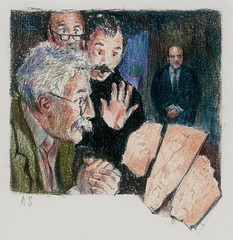
PREV ARTICLE
NEXT ARTICLE
FULL ISSUE
PREV FULL ISSUE
THE ARTIST, THE CONMAN AND THE $15 MILLION FRAUD
Here's another non-numismatic tale, this one of clever fakes and forgeries that rocked the London art market. -Editor
On a raw March morning in 2006, a posse of Scotland Yard detectives gathered outside a terraced house near the town of Bolton in one of northern England’s most deprived counties. It is a gloomy property on one end of an arc of fifties-era units; a curve of low-income brick and stucco houses that spill into a sprawling housing estate on the town’s grimy outskirts. By seven a.m., the five detectives, all part of the Yard’s Art Crime Unit, had sketched out a plan to search the house. Despite a credible tipoff, detectives still wondered if they’d made an embarrassing mistake. It was hard to imagine Number 17 housing a ring of sophisticated art forgers. But what they discovered shocked even the most seasoned of the squad: Inside was a cottage industry for faking art, where a Svengali-like conman and his vulnerable son churned out forgeries that would rock the London art world.
Dealings began in 1989, when George Sr., then in his late sixties, hawked his son’s first fake, kicking off a family forgery business that would flourish for nearly twenty years. It was Shaun who researched missing masterpieces, poring over historical details and technical descriptions. Working from old photographs or drawings he could switch artistic mediums with amazing dexterity, easily moving from an Anglo-Saxon reliquary to nineteenth-century watercolors. He tried his hand at L.S. Lowry, Henry Moore, Man Ray, Constantin Brâncuși and Otto Dix, the variance of his work prompting Scotland Yard to name him the most diverse forger in history. George Sr. in particular had a knack for learning from his mistakes. If a fake was rejected, he’d work out a better pitch and more convincing storyline. As the Crown Prosecution Service put it: “the defendants were persistent, taking failure in their stride before turning to new fakes.” The duo struck pay dirt in 1991 when two American buyers paid $160,000 for a Roman silver tray, the Risley Park Lanx. The piece was later put on display at the British Museum as a cast of the original Lanx. Business thrived: a Samuel Peploe still life sold for $32,000; a bust of Thomas Jefferson sold at Sotheby's for $77,000; a Barbara Hepworth terracotta goose was bought by the Henry Moore Institute for $4,800; and the Chicago Art Institute picked up a Gauguin sculpture for $125,000. All were fakes. Then in 2003, the Greenhalghs hit the jackpot: a $700,000 sale to the local Bolton Museum. It was a clever combination of Shaun’s delicate craftsmanship and George’s inventive record of ownership — known in the art world as provenance — that convinced Egyptologists they had discovered a rare artwork dating back more than three thousand years. The British Museum and Christie’s, which handled the sale, agreed. The twenty-one-inch alabaster figure, known as the Amarna Princess, was Shaun’s masterwork, yet he later claimed he’d carved it in just three weeks. Significantly, the translucent statue wasn’t a copy created to look like an original. This time Shaun was working fresh, creating his own vision of an Egyptian royal princess with stunning results. It was the largest-running forgery scam in recent history, and police estimate it netted the Greenhalghs about $1.6 million. They had over $600,000 sitting in bank accounts, but the only visible sign of their windfall was a new Ford Focus sitting outside the house. Indeed, by the time Scotland Yard arrived in 2006, little had changed in the more than thirty years the family had lived on the estate. Shaun still shared a small bedroom with his brother, an elderly aunt and his mother. Neighbors called them frugal, reclusive, peculiar, even a bit forlorn: Five adults crowded into a dingy three-bedroom council house. To read the complete article, see:
THE BOOK BAZARREWayne Homren, Editor The Numismatic Bibliomania Society is a non-profit organization promoting numismatic literature. See our web site at coinbooks.org. To submit items for publication in The E-Sylum, write to the Editor at this address: whomren@gmail.com To subscribe go to: https://my.binhost.com/lists/listinfo/esylum All Rights Reserved. NBS Home Page Contact the NBS webmaster 
|
